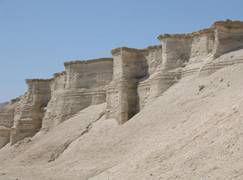Archaeologists looking for ancient biblical cities rely on the discovery of walls, gates and pottery. The identification of Sodom and Gomorrah is more elusive, since God overthrew those cities, and all the plain, and all the inhabitants of the cities, and that which grew upon the ground. Peter says He turned the cities of Sodom and Gomorrah into ashes.
The Bible insists we can see Sodom's ashes, as they were left behind for an ensample, meaning a visible exhibit of warning. Two ancient writers indicate such is the case. Josephus wrote of "... Zoar in Arabia. The country of Sodom borders it. Now this country is then so sadly burnt up, that nobody cares to come at it ... It was of old a most happy land, both for the fruits it bore and the riches of its cities, although it be now all burnt up. It is related how for the impiety of its inhabitants, it was burnt by lightning; in consequence of which there are still the remainders of that divine fire; and the traces (shadows) of the five cities are still to be seen ... marks of credibility which our very sight affords us." The well-known William Albright and his colleague, Dr. Melvin Kyle, set out to find the cities in 1924. Of their findings at the southern end of the Dead Sea, Dr. Kyle wrote, "...a region on which brimstone was rained will show brimstone. Well, it does; we picked up pure sulfur, in pieces as big as the end of my thumb. It is mixed with the marl of the mountains on the west side of the sea, and now is to be found scattered along the shore of the sea even on the east side, some four or five miles distant from the ledge that contains the stratum. It has somehow scattered far and wide over this plain." [1] In 2018, Forbes magazine reported on 13 years of archaeological research just north of the Dead Sea, where "samples from the site show that an extremely hot, explosive event leveled an area of almost 200 square miles ... not only wiping out 100 percent of the Middle Bronze Age cities and towns, but also stripping agricultural soils from once-fertile fields." [2] How hot? The researcher says, "perhaps as hot as the surface of the sun", which is around 6-10,000 degrees F.
Regarding their exact location, our best clue comes from Genesis 10:19 which says the border of the Canaanites was from Sidon, as thou comest to Gerar, unto Gaza; as thou goest, unto Sodom, and Gomorrah, and Admah, and Zeboim, even unto Lasha. 1 Samuel 13:18 indicates Zeboin was south of Jericho, placing it to the north end of the Dead Sea. Thus, these five cities were located roughly in a line, but scholars debate on which side of the sea to locate the line (see below).

In October of 1990, Ron Wyatt discovered strong evidence on the western side. He found unnatural right-angled ghost cities [1] (below) made of a flaky, powdery substance. Chemical analysis determined it to be calcium carbonate and calcium sulfate" the product of burning limestone and sulfur at temperatures above 2,200 deg. F. This material contains golf ball-sized chunks of 96-98% pure sulfur, atypical from the area's geothermal sulfur nodules at only 40% purity. These balls are encapsulated in a reddish-black, crusty ring where it suffocated. If pried out, one of these heavenly balls of wrath can still be lit, emitting a stinky blue flame. Evidence indeed!


[1] Josephus and Dr. Kyle quotes, and brimstone pictures, accessed at https://wyattmuseum.com/more-than-geological-layers/2011-125
[2] https://www.forbes.com/sites/ericmack/2018/12/04/new-science-suggests-biblical-city-of-sodom-was-smote-by-an-exploding-meteor/?sh=7e5607665c67
[3] Picture from https://bibleask.org/the-remains-of-sodom-and-gomorrah/
Like this? Consider sharing it to Facebook by clicking the linked icon below.
